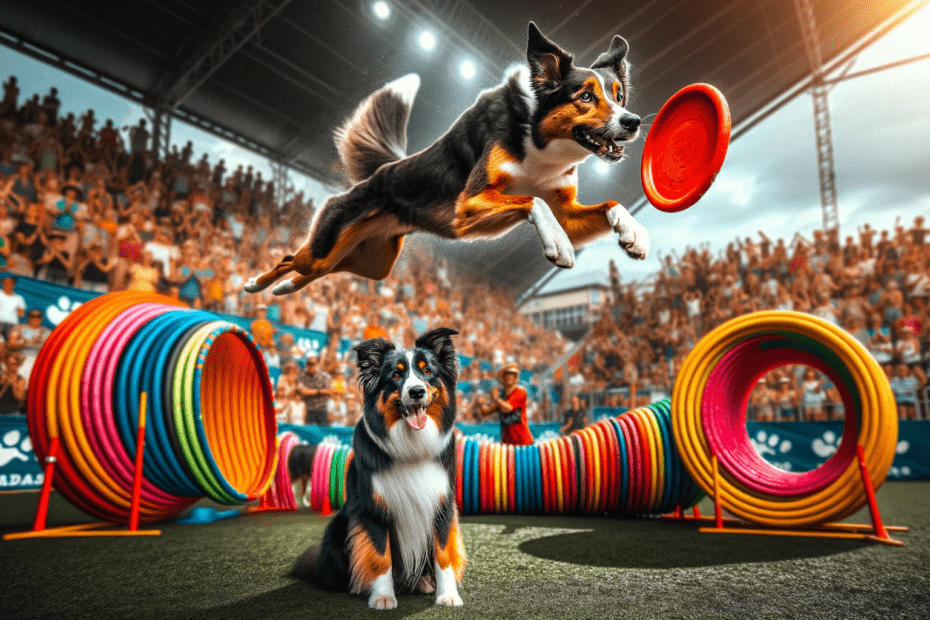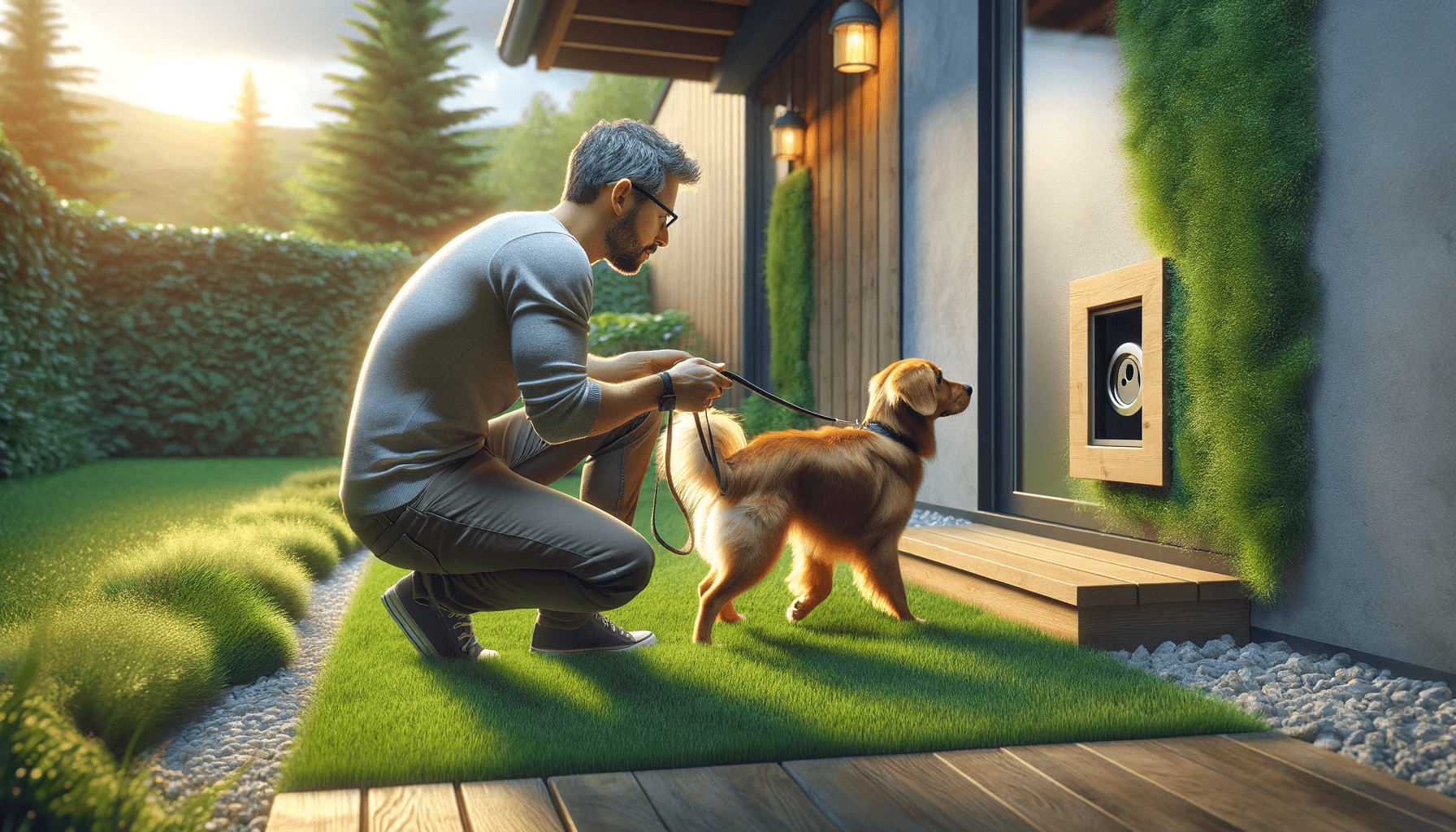Unlocking the potential of your intelligent canine starts with advanced trick training. With the right techniques and a solid training routine, you can push your dog's skills to new heights.
In this article, we'll guide you through choosing the best tricks for your dog, setting up a training routine, and troubleshooting common issues.
Get ready to take your dog's training to the next level and witness their incredible abilities shine through. Let's dive in and unlock their true potential.
Key Takeaways
- Advanced trick training provides intrinsic motivation for dogs.
- Advanced trick training strengthens the bond between dog and owner.
- Advanced trick training provides mental stimulation for dogs.
- Advanced trick training helps prevent boredom and negative behaviors in dogs.
The Benefits of Advanced Trick Training
Unlocking the full potential of your intelligent canine is made possible through advanced trick training, offering numerous benefits to both you and your furry companion.
One of the key advantages of advanced trick training is the intrinsic motivation it provides for your dog. Unlike traditional training methods that rely on external rewards like treats or praise, advanced trick training taps into your dog's natural desire to learn and problem-solve. This intrinsic motivation not only makes the training process more enjoyable for your dog, but it also strengthens the bond between you and your furry companion.
Moreover, advanced trick training provides mental stimulation for your dog. Dogs are intelligent creatures that thrive on mental challenges. By teaching them advanced tricks, you engage their minds and keep them mentally sharp. This mental stimulation is crucial for preventing boredom and the negative behaviors that often accompany it, such as excessive barking or destructive chewing.
Furthermore, the mental stimulation provided by advanced trick training has additional benefits. It can help alleviate separation anxiety, as it gives your dog a positive outlet for their energy and attention. It can also improve their overall focus and concentration, making them more responsive to your commands in various situations.
Choosing the Right Tricks for Your Dog
When choosing tricks for your dog, there are several factors to consider in order to ensure compatibility.
Assess your dog's skillset, taking into account their physical abilities and learning style.
This will help you select tricks that are suitable for their capabilities and maximize their potential for success in advanced trick training.
Trick Compatibility Factors
To choose the right tricks for your dog, consider their breed, age, and physical abilities. Trick compatibility selection is crucial for ensuring effective training and maximizing your dog's potential.
Different breeds have varying levels of intelligence and natural instincts, which can impact their ability to learn and perform certain tricks. For example, border collies are known for their high trainability and excel in complex tricks, while bulldogs may struggle with agility-based tricks due to their physical limitations.
Age also plays a role, as younger dogs tend to have more energy and enthusiasm for learning new tricks, while older dogs may have physical limitations that restrict their training adaptability.
It's important to assess your dog's physical abilities to ensure they can safely perform the chosen tricks without risking injury.
Assessing Dog's Skillset
Consider your dog's existing skills and abilities when choosing the right tricks for them. Evaluating your dog's aptitude is crucial in determining which tricks they can successfully learn and perform. Identifying potential training limitations will help you avoid frustration and ensure a positive training experience. Here are some factors to consider:
- Physical capabilities: Take into account your dog's size, strength, and stamina. Certain tricks may require agility or endurance that your dog may or may not possess.
- Temperament: Consider your dog's personality traits, such as confidence, obedience, and focus. Tricks involving complex commands or distractions may be challenging for a dog with a more independent or easily distracted nature.
- Pre-existing training: Take into consideration the skills and commands your dog already knows. Building on existing behaviors can make it easier to teach new tricks.
Setting Up a Training Routine
To set up an effective training routine, you need to consider the frequency of training sessions, time management strategies, and training environment essentials.
When it comes to frequency, aim for consistent sessions throughout the week to reinforce learning.
Efficient time management, such as breaking down training into shorter sessions, can help maintain focus and prevent fatigue.
Lastly, create a conducive training environment by minimizing distractions and ensuring adequate space for your canine companion to move and perform tricks.
Frequency of Training
When setting up a training routine for your intelligent canine, it's important to establish a consistent frequency of training sessions. Training frequency refers to the number of times you train your dog in a given period. To ensure effective learning, optimal practice time should be considered.
Here are three key factors to consider when determining the frequency of your training sessions:
- Regularity: Consistency is crucial in training your canine companion. Aim to train your dog at least three to five times a week. This regularity helps reinforce learned behaviors and prevents regression.
- Duration: Each training session should last between 10 to 15 minutes. This duration ensures that your dog remains focused and engaged throughout the session.
- Progression: As your dog becomes more adept at learning new tricks, gradually increase the frequency of training sessions. This allows for continued growth and development.
Time Management Strategies
To effectively set up a training routine for your intelligent canine, focus on efficient time management strategies. Prioritizing tasks for effective time management is crucial to ensure that you make the most out of your training sessions.
Start by identifying the specific tricks or behaviors you want to teach your dog and prioritize them based on their importance and difficulty level. This will help you allocate the appropriate amount of time for each task.
Creating a daily schedule for efficient training sessions is also essential. Set aside dedicated time slots for training and stick to them consistently. Breaking down your training sessions into smaller, focused intervals throughout the day can be more effective than one long session.
Training Environment Essentials
Now let's delve into the essential elements of setting up a training routine for your intelligent canine, so you can create an optimal training environment. To ensure effective training sessions, consider the following:
- Creating a stimulating training environment: Provide a dedicated space for training that's free from distractions. This could be a quiet room or a designated area in your backyard. Make sure the environment is comfortable and well-lit to promote focus and concentration.
- Incorporating interactive toys in trick training: Interactive toys can be powerful tools to engage your canine companion during training. Use toys that require problem-solving skills or dispense treats as rewards. These toys not only keep your dog mentally stimulated but also make the training sessions more enjoyable.
- Using positive reinforcement: Positive reinforcement is key to successful trick training. Reward your dog with treats, praise, or play whenever they perform a desired behavior. This positive association will motivate your canine friend to repeat the behavior, making the training process more effective.
Building a Strong Foundation of Basic Commands
Start by teaching your dog essential commands to establish a solid foundation for advanced trick training. It's important to differentiate between basic commands and trick commands.
Basic commands such as 'sit,' 'stay,' 'down,' and 'come' are the building blocks for more complex tricks. These commands provide the groundwork for your dog to understand and follow instructions.
To ensure your dog's obedience in various environments, it's crucial to incorporate distractions into basic command training. By gradually introducing distractions, such as noise, toys, or other animals, you can teach your dog to stay focused and respond to commands regardless of the situation.
This helps strengthen their understanding and obedience levels. Remember to use positive reinforcement techniques, such as treats or praise, to reward your dog for correctly following the commands.
Consistency and repetition are key when training your dog in basic commands. By establishing a strong foundation, you set the stage for successful advanced trick training and unlock the full potential of your intelligent canine companion.
Advanced Techniques for Challenging Tricks
Mastering challenging tricks requires applying advanced techniques to your dog's training regimen. To take your dog's trick training to the next level, consider incorporating innovative trick sequences, as well as props and accessories.
Here are three techniques to help you achieve this:
- Developing innovative trick sequences: Instead of teaching tricks in isolation, try combining them to create unique sequences. For example, you can teach your dog to jump through a hoop, spin in a circle, and then fetch a toy in a specific order. This not only challenges their cognitive abilities but also adds flair to their performance.
- Incorporating props and accessories into advanced trick training: Props and accessories can add excitement and complexity to your dog's tricks. For instance, you can teach your dog to balance on a pedestal or walk on a tightrope. By introducing these props, you create a visually appealing performance that showcases your dog's advanced abilities.
- Building on foundational skills: Advanced tricks often require a solid foundation in basic commands. By reinforcing your dog's understanding of core commands like sit, stay, and come, you provide a strong base for more complex tricks. Additionally, advanced tricks may require your dog to learn new commands, such as targeting specific objects or performing actions on cue.
Troubleshooting Common Training Issues
To address common training issues, continue incorporating the advanced techniques discussed earlier in your dog's trick training. When troubleshooting leash pulling, it's essential to remember that this behavior is often driven by excitement or a desire to explore. To mitigate this, practice loose leash walking in low-distraction environments, gradually increasing the level of distraction as your dog becomes more proficient. Use positive reinforcement, rewarding your dog for walking beside you without pulling. Additionally, consider using a front-clip harness or head halter to provide more control during walks.
Addressing fear-based behavior requires a patient and gradual approach. Identify the specific triggers that cause fear in your dog, and create a positive association with those triggers through counterconditioning and desensitization. For example, if your dog is afraid of loud noises, start by playing a low volume recording of the noise and reward your dog for remaining calm. Gradually increase the volume over time, always rewarding calm behavior. It's important not to force your dog into situations that cause fear, as this can worsen the behavior.
Taking Trick Training to the Next Level
Once you have built a strong foundation of basic tricks, it's time to delve into more advanced trick training with your intelligent canine. To take your trick training to the next level, consider incorporating props and obstacles into your training sessions. This won't only provide mental stimulation for your dog but also add an element of challenge to their training routine.
Here are three ideas to get you started:
- Set up a mini agility course in your backyard or living room. Use cones, tunnels, and jumps to create a stimulating obstacle course for your dog to navigate. This will enhance their physical coordination and problem-solving skills.
- Introduce props such as hoops, platforms, or balance balls. Teach your dog to jump through hoops, spin on platforms, or balance on balls. These props won't only add variety to their training but also improve their balance and body awareness.
- Incorporate everyday objects into your trick training. Teach your dog to fetch specific items, open doors, or even tidy up their toys. This will showcase their intelligence and problem-solving abilities.
In addition to incorporating props and obstacles, consider exploring the use of clicker training in advanced trick training. Clicker training is a positive reinforcement technique that uses a clicker to mark desired behaviors. This precise form of communication can help your dog learn complex tricks more quickly and effectively.
Frequently Asked Questions
Can Advanced Trick Training Be Harmful for My Dog's Physical Health?
Advanced trick training can have potential risks for your dog's physical health. It is crucial to use proper conditioning and training techniques to minimize these risks.
How Long Does It Typically Take to Teach a Dog an Advanced Trick?
Teaching advanced tricks to a dog can take varying amounts of time depending on the complexity of the trick and the dog's learning ability. Techniques like positive reinforcement and breaking down the trick into smaller steps can speed up the training process. Common challenges include distractions, lack of motivation, and difficulty in understanding the desired behavior.
Can Any Dog Breed Participate in Advanced Trick Training?
Any dog breed can participate in advanced trick training. There are no breed restrictions in unlocking the potential of intelligent canines. The benefits of advanced trick training include mental stimulation, improved obedience, and strengthened bond between you and your furry friend.
Are There Any Age Restrictions for Dogs to Start Advanced Trick Training?
Starting advanced trick training at a young age has many benefits. It helps develop cognitive abilities, enhances problem-solving skills, and fosters a stronger bond between you and your dog. For older dogs, adapt the training to their physical limitations while still challenging their minds.
Are There Any Specific Treats or Rewards That Are More Effective for Advanced Trick Training?
High value treats and clicker training techniques are effective for advanced trick training. They provide motivation and reinforcement for your dog's desired behaviors. Using these techniques can enhance your dog's learning and performance in advanced tricks.
Conclusion
In conclusion, advanced trick training for canines offers numerous benefits. These include mental stimulation, improved obedience, and a strengthened bond between dog and owner. By selecting the right tricks, establishing a consistent training routine, and building a solid foundation of basic commands, dogs can master challenging tricks and overcome common training issues.
With dedication and patience, owners can unlock the full potential of their intelligent canines and take trick training to the next level.






